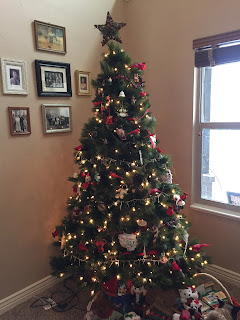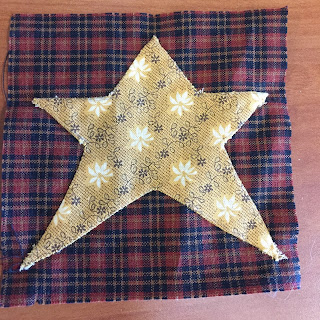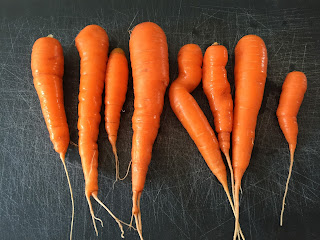I should also add that I will be talking about machine quilting that involves the use of a walking foot rather than free motion quilting. While I have attempted some projects with a free motion foot, my skills are very limited. Perhaps I will continue to develop them in the new year.
A walking foot is a sewing machine attachment that provides a top set of feed dogs. This allows the upper and lower fabrics to move through the machine at the same rate. When you are working with a quilt with its back, batting, and top, you definitely want to avoid the layers shifting as you work. My walking foot came with my machine accessories. If you don't have a walking foot, they can be purchased for around $20 to $40. Looking at the online pictures, this accessory doesn't appear to be machine brand specific, but you could always ask at the store.
The project that I will be sharing in this post is a miniature quilt made with Civil War Reproduction Fabrics, which are some of my favorites. This quilt pattern is titled, "Small Joys," and is featured in the book, Civil War Legacies II.
I picked up the kit for this quilt from a darling shop, Corn Wagon Quilts, in Springville, Utah. This shop is in a historic building which adds to its charm. This shop features reproduction fabric projects as well as wool appliqué projects. It's probably a good thing for my budget that this shop is about an hour and a half from my home. Here are some of the miniature 9-patch blocks that are featured in this quilt.
When contemplating having a project quilted whether you are quilting by hand or machine, doing it yourself or having someone else do the work, the first question to ask is "How do you want it quilted?" I found myself a bit puzzled the first time I was asked that question. I was thinking, "You are the expert, that's why I'm coming to you." Here are a few things to think about as well as the rationale for some of the choices I made in relation to this project.
- The style of the quilt. The overall style of the quilt itself is going to help drive decisions about quilting. The choice of quilting pattern should match the quilt's style. A more geometric pattern may be appropriate for a quilt with more modern colors and larger blocks. For this particular quilt that only measures about 18 x 22 inches, I wanted a more simple pattern and one that would fit with the reproduction style fabrics. I opted to go with a cross-hatch pattern that essentially made Xs through each block. This is also the pattern that was featured on the example in the book. It is also a pattern that is rather forgiving for a novice machine quilter.
- Choice of batting. I tend to like an 80/20 blend batting for my quilts. This tends to provide warmth without too much bulk. Given that this was a small quilt, I had a scrap leftover from a larger project that was just the right size.
- Choice of thread. Again, you want to think about the colors in your quilt and how "visible" or not you want the quilting thread to be. I have some quilts with darker colors for which a lighter thread that stands out is a nice option. In this case, my quilt had a mixture of dark, light, and medium colors. My goal was to have the quilting blend in with the quilt itself. I opted to go with a coral thread that blended in with the flowers in the dark red border. It also blended in with the solid pink blocks within the quilt and didn't provide too high or a contrast with the light fabrics in the 9-patch blocks. As you can see in the picture, I unrolled the spool of thread a little so that I could lay the strand of thread out on the quilt to see how it might look before proceeding with the project.
- Choice of backing. This really can be anything you want. You can even sew two or more pieces together to get the size of backing that you need. Your backing does need to be about 2-3 inches wider all the way around relative to your quilt top. For a smaller piece such as this one, you can go closer to 2 inches. I elected to use a reproduction style fabric that was different from the fabrics in the quilt itself yet still fit with the larger theme. A solid color also would have worked just fine. Remember that this is the back and not the side people will be looking at. It's also your quilt so feel free to also select a design that is completely different and distinct from the quilt top.


- Mark the design on the quilt top. There are multiple options for marking quilt tops. The main thing is that you don't mix heat-soluble and water-soluble marking pens. For a mostly dark top like this one, my marker of choice is a white Clover brand marking pen. This is a heat-soluble marker that looks like chalk on the fabric. The marks didn't show up very well in any of the pictures I took, but they were adequate for sewing. Since I was using a cross-hatch design on this top, I just used a large ruler and drew the lines across the quilt going both directions.
- Secure the backing to the work surface. This is where I like to have a work surface that can tolerate safety pins. I have a couple of plastic-topped tables that I like to work on when doing this phase of the work. Painter's tape is also a great accessory for this phase because it will hold the fabric in place without leaving a residue behind. You want to have the quilt back tight and secure. Here is a picture of what mine looked like.
- Lay the batting and quilt top on top of the back. These two pieces do not need to be secured as tightly as the back. Lay the batting out on top of the back and then smooth out the quilt top on the back and batting layers. You can see from the picture how the batting and back extend beyond the edges of the quilt top.
- Pin the three layers together. This is what is going to secure the quilt layers together and allow you do do the machine stitching. As you can see from the picture, I have placed safety pins every 2-3 inches across the quilt top. You just remove them as you sew along so don't be intimidated. I'm also featuring a picture of my favorite tool for securing the safety pins. This tool definitely helps prevent broken fingernails and punctured fingertips in the pinning process. You can buy one at a local quilt shop.

- Machine quilt along the marked lines. The marked lines didn't show up well in any of my photographs, but they were sufficiently visible for me to see them and stitch on top of them. When sewing, start near the middle of the project (in my case, I started near a middle edge), and move outward. This also helps keep the project smooth. With the cross-hatch design, I would sew one diagonal line across the quilt, pivot the piece, sew along the edge until I reached the next marked line and then proceed back across the quilt. I more or less repeated this pattern until the quilting was complete.
- Bind the quilt and enjoy. I cut my binding 2 1/4 inches wide and then double fold it. Feel free to use your preferred technique to bind your quilt. I also tend to add in a muslin sleeve (or loops) for hanging so that I can decide later how I wish to display my quilt.
As much as I enjoy Civil War history as well as the fabrics and styles of this era, I am troubled at this divisive time in our nation's history. I will close out this post reflecting on some of the final earthly words of the Prince of Peace. In the midst of divisive, troubling times in our world, they provide a source of perspective on true peace and the assurance that believers have. Wishing you a truly blessed 2016.
Peace I leave with you; My peace I give to you; not as the world gives do I give to you. Do not let your heart be troubled, nor let it be fearful. John 14:27
These things I have spoken to you, so that in Me you may have peace. In the world you have tribulation, but take courage; I have overcome the world. John 16:33.


















































